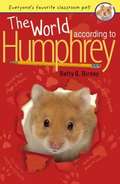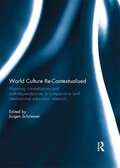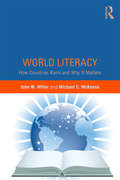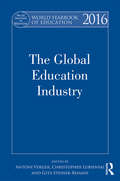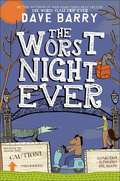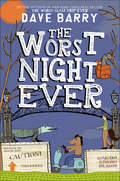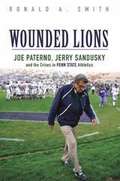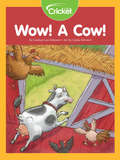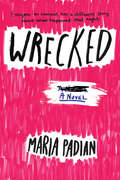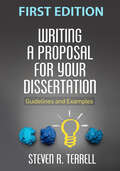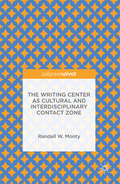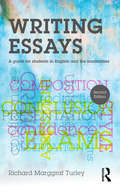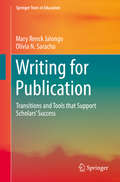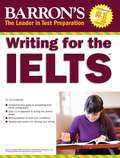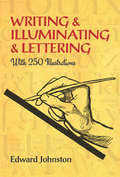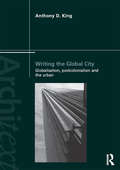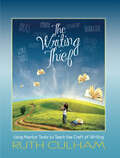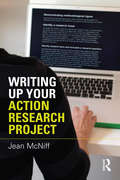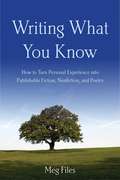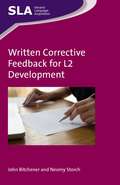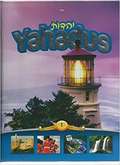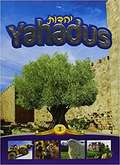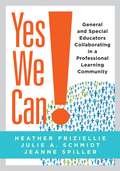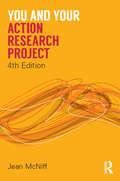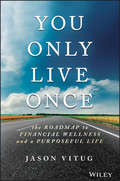- Table View
- List View
The World (According to Humphrey #1)
by Betty G. BirneyThe first book in the series about everyone's favorite classroom pet! <P>You can learn a lot about life by observing another species. <P><P>That’s what Humphrey was told when he was first brought to Room 26. And boy, is it true! <P>In addition to having FUN-FUN-FUN in class, each weekend this amazing hamster gets to sleep over with a different student, like Lower-Your-Voice-A.J. and Speak-Up-Sayeh. <P>Soon Humphrey learns to read, write, and even shoot rubber bands (only in self-defense, of course). <P>With lots of friends to help, adventures to enjoy, and a cage with a lock-that-doesn’t- lock, Humphrey's life is almost perfect. <P>If only the teacher, Mrs. Brisbane, wasn’t out to get him! <P>Boys and girls can't help falling in love with Humphrey!
World Culture Re-Contextualised: Meaning Constellations and Path-Dependencies in Comparative and International Education Research
by Jürgen SchriewerImpressive strands of research have shown the emergent reality of increasing world-level interconnection in almost every field of social action. As a consequence, theories and models have been developed which are aimed at conceptualising this new reality along the lines of an ‘institutionalised’ World Culture. This offers a new understanding of the worldwide diffusion of specifically modern – i.e. mainly Western – rules, ideologies and organisational patterns, and of attendant harmonisation and standardisation of fields of social action. World Culture theories have not gone unchallenged. Rather, cross-cultural studies have revealed much more complex processes of regional fragmentation and (re-)diversification; of the refraction, appropriation, and hybridisation, through distinct socio-cultural conditioning, of world-level models and ideas; and of the ongoing effectiveness both of structural path-dependencies and of specifically cultural aspects such as collective memories, social meanings, and religious (or ideological) belief systems. Comparative research has thus highlighted an intricate simultaneity of contrary currents: of the increasing world-level interconnection of communication and exchange relations on the one hand, and, on the other, the persistence of context-specific interpretations, translations, and deviation-generating re-contextualisations of world-level forces and challenges.This research provides the theoretical problematique that animates this volume. The chapters explore the conceptual tools and explanatory power of theories and models which do not just oppose or reject World Culture theory, but are instead suited to complementing and differentiating it. The volume offers an enlightening conceptualisation of the intricate interaction of global processes with local agency, and of world-level forces with the self-evolutionary potentials inherent in specific contexts, socio-cultural structures, and distinctive meanings constellations. This book was originally published as a special issue of Comparative Education.
World Literacy: How Countries Rank and Why It Matters
by Michael C. McKenna John W. MillerInternational literacy assessments have provided ample data for ranking nations, charting growth, and casting blame. Summarizing the findings of these assessments, which afford a useful vantage from which to view world literacy as it evolves, this book examines literate behavior worldwide, in terms of both the ability of populations from a wide variety of nations to read and the practice of literate behavior in those nations. Drawing on The World’s Most Literate Nations, author Jack Miller’s internationally released study, emerging trends in world literacy and their relationships to political, economic, and social factors are explored. Literacy, and in particular the practice of literate behaviors, is used as a lens through which to view countries’ economic development, gender equality, resource utilization, and ethnic discrimination. Above all, this book is about trajectories. It begins with historical contexts, described in terms of support for literate cultures. Based on a variety of data sources, these trends are traced to the present and then projected ahead. The literate futures of nations are discussed and how these relate to their economic and sociocultural development. This book is unique in providing a broader perspective on an intractable problem, a vantage point that offers useful insights to inform policy, and in bringing together an array of relevant data sources not typically associated with literacy status.
World Yearbook of Education 2016: The Global Education Industry (World Yearbook of Education)
by Antoni Verger Christopher Lubienski Gita Steiner-KhamsiThis latest volume in the World Yearbook of Education series examines the global education industry both in OECD* countries as well as developing countries, and presents the works of scholars based in different parts of the word who have significantly contributed to this area of research. Focusing on the areas of cross-over in public-private partnerships in education, WYBE 2016 critically examines the actors and factors that have propelled the global rise of the education industry. Split into three key sections, Part I explores how education agendas are shaped; Part II considers the private financing of education and the export of school improvements to professional consultancies; and Part III analyses new market niches, such as low-fee private schooling and for-profit education provisions. The book draws upon case studies of many global organizations, including: The Bill and Melinda Gates Foundation Pearson Affordable Learning Fund Bridge International Academies Teach for All Omega Schools Co-edited by three internationally renowned scholars, Antoni Verger, Christopher Lubienski and Gita Steiner-Khamsi, WYBE 2016 will be a valuable resource for researchers, graduates and policy makers who are interested in the global education industry. *Convention on the Organisation for Economic Co-operation and Development.
The Worst Night Ever (Class Trip Ser.)
by Dave Barry Grzegorz KrysinskiLast year, Wyatt Palmer was the hero of middle school, having foiled a plot against the president of the United States. But now he and his friends are in Coral Cove High School-home of the Fighting Conchs-and Wyatt is no longer a hero: He's just another undersized freshman, hoping to fit in, or at least not be unpopular. Things start to go wrong when Matt Diaz, who is Wyatt's best friend but also unfortunately an idiot, decides to bring his pet ferret, Frank, to school. Through an unfortunate series of events Frank ends up in the hands of the Bevin brothers, who are the most popular boys at Coral Cove High, but are also, as Matt soon discovers, the nastiest. When Wyatt and Matt try to get Frank back, they concoct a plan to attend a party for the cool clique at the Bevin's waterfront mansion and stumble onto the Bevin family's dark and deadly secret. That's when Wyatt learns that some things are worse than being unpopular in high school. MUCH worse.
The Worst Night Ever (Class Trip #2)
by Dave BarryLast year, Wyatt Palmer was the hero of middle school, having foiled a plot against the president of the United States. But now he and his friends are in Coral Cove High School -- home of the Fighting Conchs -- and Wyatt is no longer a hero: He's just another undersized freshman, hoping to fit in, or at least not be unpopular. Things start to go wrong when Matt Diaz, who is Wyatt's best friend but also unfortunately an idiot, decides to bring his pet ferret, Frank, to school. Through an unfortunate series of events Frank ends up in the hands of the Bevin brothers, who are the most popular boys at Coral Cove High, but are also, as Matt soon discovers, the nastiest. When Wyatt and Matt try to get Frank back, they concoct a plan to attend a party for the cool clique at the Bevin's waterfront mansion and stumble onto the Bevin family's dark and deadly secret. That's when Wyatt learns that some things are worse than being unpopular in high school. MUCH worse.
Wounded Lions: Joe Paterno, Jerry Sandusky, and the Crises in Penn State Athletics
by Ronald A. SmithThe Jerry Sandusky child molestation case stunned the nation. As subsequent revelations uncovered an athletic program operating free of oversight, university officials faced criminal charges while unprecedented NCAA sanctions hammered Penn State football and blackened the reputation of coach Joe Paterno. In Wounded Lions , acclaimed sport historian and longtime Penn State professor Ronald A. Smith draws from university archives to answer the How? and Why? at the heart of the scandal. The Sandusky case was far from the first example of illegal behavior related to the football program--or the university's attempts to suppress news of it. As Smith shows, decades of infighting among administrators, alumni, trustees, faculty, and coaches established policies intended to protect the university, and the football team considered synonymous with its name, at all costs. If the habits predated Paterno, they also became sanctified during his tenure. Smith names names to show how abuses of power warped the "Penn State Way" even with hires like women's basketball coach Rene Portland, who allegedly practiced sexual bias against players for decades. Smith also details a system that concealed Sandusky's horrific acts just as deftly as it whitewashed years of rules violations, coaching malfeasance, and player crime while Paterno set records and raised hundreds of millions of dollars for the university.
Wow! A Cow!
by Lindsay Lee JohnsonSomeone leaves the barn door open and there's chaos. Find out how Blue the dog comes to the rescue.
Wrecked
by Maria PadianWhat really happened at the party that night? Haley saw Jenny come back to the dorm, shell-shocked. Richard heard Jordan brag about the cute freshman he hooked up with. When Jenny accuses Jordan of rape, Jordan claims she’s lying. Haley and Richard, who have just started dating, are pushed to opposite sides of the school’s investigation. Will the truth ever come to light? Reputations, relationships, and whole lives depend on it.
Writing a Proposal for Your Dissertation
by Steven R. TerrellThis user-friendly guide helps students get started on--and complete--a successful doctoral dissertation proposal by accessibly explaining the process and breaking it down into manageable steps. Steven R. Terrell demonstrates how to write each chapter of the proposal, including the problem statement, purpose statement, and research questions and hypotheses; literature review; and detailed plan for data collection and analysis. Of special utility, end-of-chapter exercises serve as building blocks for developing a full draft of an original proposal. Numerous case study examples are drawn from across the social, behavioral, and health science disciplines. Appendices present an exemplary proposal written three ways to encompass quantitative, qualitative, and mixed-methods designs. Pedagogical Features: *"Let's Start Writing" exercises leading up to a complete proposal draft. *"Do You Understand?" checklists of key terms plus an end-of-book glossary. *End-of-chapter quizzes with answers. *Case study examples from education, psychology, health sciences, business, and information systems. *Sample proposal with three variants of the methods chapter: quantitative, qualitative, and mixed methods.
The Writing Center as Cultural and Interdisciplinary Contact Zone
by Randall W. MontyWriting centers are complex. They are places of scholarly work, spaces of interdisciplinary interaction, and programs of service, among other things. With this complexity in mind, this book theorizes writing center studies as a function of its own rhetorical and discursive practices. In other words, the things we do and make define who we are and what we value. Through a comprehensive methodological framework grounded in critical discourse analysis, this book takes a closer look at prominent writing center discourses by temporarily shifting attention away from the stakeholders, work, locations, and scholarship of the discipline, and onto things--the artifacts and networks that make up the discipline. Through this approach, we can see the ways the discipline reinforces, challenges, reproduces, and subverts structures of institutional power. As a result, writing center studies can be seen a vast ecosystem of interconnectivity and intertextuality.
Writing Essays: A guide for students in English and the humanities
by Richard Marggraf TurleyEssays are a major form of assessment in higher education today and this is a fact that causes some writers a great deal of anxiety. Fortunately, essay writing is a skill that can be learned, like any other. Through precise explanations, this fully updated edition of Writing Essays gives you the confidence to express yourself coherently and effectively. It demystifies the entire process of essay writing, helping you to become proficient and confident in every aspect. Writing Essays reveals the tricks of the trade, making your student life easier. You’ll learn how to impress tutors by discovering exactly what markers look for when they read your work. Using practical examples selected from real student assignments and tutor feedback, this book covers every aspect of composition, from introductions and conclusions, down to presentation and submission. It also advises you on stress-free methods of revision, helps with exam essays, explains the principles of effective secondary source management, and shows you how to engage meaningfully with other critics’ views. A new chapter will also guide you through the intricacies of the undergraduate dissertation. As a full-time university professor, Richard Marggraf Turley counsels students and assesses their work every day, helping him to recognise the challenges that they face. Accessible, concise and full of practical examples, Writing Essays is a response to these challenges and will be an invaluable companion for Humanities students who wish to improve their grades and become confident in the art of essay writing.
Writing for Publication
by Mary Renck Jalongo Olivia N. SarachoThis book offers systematic instruction and evidence-based guidance to academic authors. It demystifies scholarly writing and helps build both confidence and skill in aspiring and experienced authors. The first part of the book focuses on the author's role, writing's risks and rewards, practical strategies for improving writing, and ethical issues. Part Two focuses on the most common writing tasks: conference proposals, practical articles, research articles, and books. Each chapter is replete with specific examples, templates to generate a first draft, and checklists or rubrics for self-evaluation. The final section of the book counsels graduate students and professors on selecting the most promising projects; generating multiple related, yet distinctive, publications from the same body of work; and using writing as a tool for professional development. Written by a team that represents outstanding teaching, award-winning writing, and extensive editorial experience, the book leads teacher/scholar/authors to replace the old "publish or perish" dictum with a different, growth-seeking orientation: publish and flourish.
Writing for the IELTS
by Lin LougheedDiscover everything you’ll need to know in order to write well for the IELTS test, whether you are planning to take the Academic or the General Training version. This book will help IELTS test takers learn several essential skills, including:Task Achievement: follow a three-step model to plan, write, and revise your essaysCoherence and Cohesion: practice organizing your writing and connecting ideasLexical Resource: build your vocabulary and use it correctlyGrammatical Range and Accuracy: review rules and practice applying them to your writingEach section leads you step-by-step through the process of writing an essay in response to a particular task. Learn how to apply what you’ve learned, familiarize yourself with the types of questions you’ll have to respond to on the test, complete your responses within the time limits, and more. An Appendix also includes a More Writing Practice section with a selection of essays written in response to IELTS writing tasks.
Writing & Illuminating & Lettering: With 250 Illustrations
by Edward JohnstonOne of the founders of modern calligraphy, Edward Johnston regarded lettering, writing, and illuminating as not only desirable ends in themselves but also as practical avenues to mastery of typography, decoration, and design. In this classic, profusely illustrated guide, he distilled his expertise into a series of easy-to-follow lessons that will benefit any student of calligraphy, book design, or art.Part I is devoted to writing and illuminating. Early chapters cover the fundamentals of acquiring a formal hand: choosing paper, ink, and quills; holding the pen; spacing and planning a manuscript; and more. The author then turns to the techniques of producing a manuscript book: tools and materials, methods and proportions, margins, and other methods. Part II offers a detailed discussion of lettering: the qualities of good lettering, methods of construction and arrangement, spacing, proportion, and other matters. Two appendixes cover the uses of lettering in book bindings, wall inscriptions, monograms, and title pages as well as the techniques involved in lettering on metal, wood, and stone.
Writing the Global City: Globalisation, Postcolonialism and the Urban (Architext)
by Anthony D KingOver the last three decades, our understanding of the city worldwide has been revolutionized by three innovative theoretical concepts – globalisation, postcolonialism and a radically contested notion of modernity. The idea and even the reality of the city has been extended out of the state and nation and re-positioned in the larger global world. In this book Anthony King brings together key essays written over this period, much of it dominated by debates about the world or global city. Challenging assumptions and silences behind these debates, King provides largely ignored historical and cultural dimensions to the understanding of world city formation as well as decline. Interdisciplinary and comparative, the essays address new ways of framing contemporary themes: the imperial and colonial origin of contemporary world and global cities, actually existing postcolonialisms, claims about urban and cultural homogenisation and the role of architecture and built environment in that process. Also addressed are arguments about indigenous and exogenous perspectives, Eurocentricism, ways of framing vernacular architecture, and the global historical sociology of building types. Wide-ranging and accessible, Writing the Global City provides essential historical contexts and theoretical frameworks for understanding contemporary urban and architectural debates. Extensive bibliographies will make it essential for teaching, reference and research.
Writing Thief: Using Mentor Texts to Teach the Craft of Writing
by Ruth CulhamMediocre writers borrow. Great writers steal. --T.S. EliotWriting thieves read widely, dive deeply into texts, and steal bits and pieces from great texts as models for their own writing. Author Ruth Culham admits to being a writing thief'sand she wants you and your students to become writing thieves, too! In The Writing Thief: Using Mentor Texts to Teach the Craft of Writing, Culham demonstrates a major part of good writing instruction is finding the right mentor texts to share with students. Within this book, you'll discover more than 90 excellent mentor texts, along with straight-forward activities that incorporate the traits of writing across informational, narrative, and argument modes. Chapters also include brief essays from beloved writing thieves such as Lester Laminack, David L. Harrison, Lisa Yee, Nicola Davies, Ralph Fletcher, Toni Buzzeo, Lola Schaefer, and Kate Messner, detailing the reading that has influenced their own writing. Culham's renowned easy-going style and friendly tone make this a book you'll turn to again and again as you coach your students to reach their full potential as deep, thoughtful readers and great writers. There's a writing thief in each of us when we learn how to read with a writer's eye!
Writing Up Your Action Research Project
by Jean McNiffMany practice-based researchers have expert knowledge of doing research but often experience difficulties when writing it up and communicating the significance of what they have done. This book aims to help bridge the gap. Packed with practical advice and strong theoretical resources it takes you through the basics of designing and producing your text so that it will meet established standards and high quality assurance expectations. Divided into 3 distinctive parts, key points include: understanding writing practices engaging with the literatures how to write up a project report or dissertation how writing is judged in terms of professional and academic writing practices developing ideas for further study and publication Writing up Your Action Research Project is an essential text for practitioners on professional education and undergraduate courses across disciplines who want their writing to reflect the excellence of their research. It is the ideal companion to the author’s You and Your Action Research Project, now in its fourth edition.
Writing What You Know: How to Turn Personal Experiences into Publishable Fiction, Nonfiction, and Poetry
by Meg FilesIt's easy for people to write about their feelings in a journal. It's more difficult, however, to convert personal experiences into stories worthy of publication-fiction, non-fiction, or poetry. Filled with engaging exercises, Write from Life guides writers in identifying story-worthy material and transforming their raw material into finished pieces, through conquering fears associated with personal exposure, determining a story's focus, shaping the material into a cohesive whole, and editing and revising as needed. Writers working in any form will find this book invaluable for supplying them with the inspiration and practical instruction they need to get their experiences and emotions into print. In addition, they will learn to:Tap into difficult, guarded parts of their lives to tell the stories they desireWrite emotionally intense materialDecide which literary form is right for their storiesCreate the illusion of real speech with effective dialogueTell their stories with authorityDevelop effective beginnings, middles, and endsShare their work with others and deal with reactions courageouslyFiles' friendly, encouraging advice makes it a pleasure for writers to write the stories they are most passionate about. In an age when publishing can mean pushing a button on Facebook, Twitter, or a blog, there is an enduring urge to send stories out into the world. In an atmosphere of misinformation and lies that social media and the ease of publishing may encourage, we especially crave truth. The time to start telling it is now-so many aspiring writers have truths worth sharing and stories begging to be told!Allworth Press, an imprint of Skyhorse Publishing, publishes a broad range of books on the visual and performing arts, with emphasis on the business of art. Our titles cover subjects such as graphic design, theater, branding, fine art, photography, interior design, writing, acting, film, how to start careers, business and legal forms, business practices, and more. While we don't aspire to publish a New York Times bestseller or a national bestseller, we are deeply committed to quality books that help creative professionals succeed and thrive. We often publish in areas overlooked by other publishers and welcome the author whose expertise can help our audience of readers.
Written Corrective Feedback for L2 Development
by Neomy Storch John BitchenerWritten corrective feedback (CF) is a written response to a linguistic error that has been made in the writing of a text by a second language (L2) learner. This book aims to further our understanding of whether or not written CF has the potential to facilitate L2 development over time. Chapters draw on cognitive and sociocultural theoretical perspectives and review empirical research to determine whether or not, and the extent to which, written CF has been found to assist L2 development. Cognitive processing conditions are considered in the examination of its effectiveness, as well as context-related and individual learner factors or variables that have been hypothesised and shown to facilitate or impede the effectiveness of written CF for L2 development.
Yahadus Curriculum Book 1
by Living LessonsMadah and Ahavah Living Lessons' flagship Yahadus curriculum gives a strong overview of the entire Torah over five years (fourth through eighth grade) with the mitzvos as a framework. <P><P> Each year, students learn approximately 120 Mitzvos, and the curriculum adjusts in content, language and design to suit the target age level. <P><P> The Rambam's order of the mitzvos, organized by subject, has been used, with rare exceptions. This logical sequence makes it much easier for children to connect to and retain the information. <P><P> The curriculum starts in fourth grade with the mitzvos of Sefer Madda, and ends with Sefer Shoftim in eighth grade. There is one student textbook for each year. Four volumes are now available, with the fifth and final volume coming soon b'ezras Hashem. The textbooks are sturdy and designed to last for a number of years by the students in each grade. <P><P> A two-part Teacher s Guide, as well as a workbook with activities is available for the students to use. <P><P> While every school is constantly challenged to squeeze in everything they want to teach into their limited time resources - as they should be - this curriculum is a tremendous asset, as it can change the approach of the teachers and students to the entire learning process. <P><P> The curriculum also covers many aspects of any Jewish Studies curriculum, being that it goes through all 613 mitzvos, and thus may free up some of the time needed for them. <P><P> It is designed to use approximately 90 minutes per week. <P><P> The curriculum is built with much flexibility in the time it will use: <P><P> It can be taught either in varying timeframes (1 - 2 longer sessions per week, or 3 - 4 shorter ones.) <P><P> Much of the information is optional and the layout is designed to allow it to easily be included or omitted in classroom instruction based on time allowances. <P><P> It reads easily and is visually attractive enough for students to take home and prepare varying amounts of the text before class. <P><P> Living Lessons is a grass-roots effort to create high-quality Torah learning materials for children. Benefiting from the latest educational methods, and without compromising our rich Mesorah, a group of dedicated individuals have undertaken the monumental task of preparing materials to make Torah engaging, meaningful and exciting to learn and teach. <P><P> The first result of the this effort is the state-of-the-art Yahadus curriculum, designed by a team of Mechanchim and Mechanchos, Rabbonim, researchers, writers, designers, parents, and children. Other exciting projects are underway. Stay tuned for updates!
Yahadus Student's Textbook 3
by Living LessonsZeraim and Avodah (1) Living Lessons' flagship Yahadus curriculum gives a strong overview of the entire Torah over five years (fourth through eighth grade) with the mitzvos as a framework. Each year, students learn approximately 120 Mitzvos, and the curriculum adjusts in content, language and design to suit the target age level. The Rambam's order of the mitzvos, organized by subject, has been used, with rare exceptions. This logical sequence makes it much easier for children to connect to and retain the information. The curriculum starts in fourth grade with the mitzvos of Sefer Madda, and ends with Sefer Shoftim in eighth grade. There is one student textbook for each year. Four volumes are now available, with the fifth and final volume coming soon b'ezras Hashem. The textbooks are sturdy and designed to last for a number of years by the students in each grade. A two-part Teacher s Guide, as well as a workbook with activities is available for the students to use. While every school is constantly challenged to squeeze in everything they want to teach into their limited time resources - as they should be - this curriculum is a tremendous asset, as it can change the approach of the teachers and students to the entire learning process. The curriculum also covers many aspects of any Jewish Studies curriculum, being that it goes through all 613 mitzvos, and thus may free up some of the time needed for them. It is designed to use approximately 90 minutes per week. The curriculum is built with much flexibility in the time it will use: It can be taught either in varying timeframes (1 - 2 longer sessions per week, or 3 - 4 shorter ones.) Much of the information is optional and the layout is designed to allow it to easily be included or omitted in classroom instruction based on time allowances. It reads easily and is visually attractive enough for students to take home and prepare varying amounts of the text before class. Living Lessons is a grass-roots effort to create high-quality Torah learning materials for children. Benefiting from the latest educational methods, and without compromising our rich Mesorah, a group of dedicated individuals have undertaken the monumental task of preparing materials to make Torah engaging, meaningful and exciting to learn and teach. The first result of the this effort is the state-of-the-art Yahadus curriculum, designed by a team of Mechanchim and Mechanchos, Rabbonim, researchers, writers, designers, parents, and children. Other exciting projects are underway. Stay tuned for updates!
Yes We Can! General and Special Educators Collaborating in a Professional Learning Community
by Heather Friziellie Julie A. Schmidt Jeanne SpillerAs states adopt more rigorous academic standards, schools must define how special education fits into standards-aligned curricula, instruction, and assessment. Utilizing PLC practices, general and special educators must develop collaborative partnerships in order to close the achievement gap and maximize learning for all. The authors encourage all educators to take collective responsibility in improving outcomes for students with special needs.
You and Your Action Research Project
by Jean McniffYou and Your Action Research Project is packed full of useful advice to take the reader through the various stages of an action research project. Written for practitioners across professions who are studying on work-based learning programmes and award-bearing courses, this book contains practical strategies for improving project work. Split into the following five sections; Thinking about doing a project, Getting ready to do a project, Planning a project and managing it, Doing your project, Evaluating your action research project, the structure is clearly accessible and easy-to-read, encouraging readers of cross-curricular interests from teachers, to nurses and social workers to try new approaches. This fourth edition of the best-seller has been thoroughly updated and improved, with new and up-to-date case study material from a very wide range of disciplines, greater emphasis on the need for dialogical practices, points for reflection, more developed ideas about sorting and analysing data, and a stronger focus on writing as a form of research. With key sections on engaging with the literatures and collaborative practices, whilst also developing ideas about writing and data analysis, this book will be essential reading for those wanting to begin and further develop their action research. Jean McNiff is an independent researcher and writer, Professor of Educational Research at York St John University, and Adjunct Professor at the University of Limerick. She is also the author of key text Action Research: Principles and Practice.
You Only Live Once: The Roadmap to Financial Wellness and a Purposeful Life
by Jason VitugGet your finances in order with smart budgeting and money mindfulness You Only Live Once is the guide to achieving your best life through smart money moves. Before you even begin making a budget, you need to think about why. Where do you see yourself financially in ten years? Five years? This time next year? What does money do for you? Once you know your destination, you can begin charting your course. Step-by-step guidance walks you through the budgeting process, and shows you how to plan your financial path to point toward your goals. You'll learn how to prioritize spending, how to save efficiently, and how to take advantage of simple tools you didn't know you had. Next comes the most important part: taking control. You need to really look at how you perceive and use money day-to-day. Chances are, changing a few habits could give you some breathing room and help you reach your goals sooner. You work hard for your money, yet there never seems to be enough. You don't need to live like a pauper, but you need to be truly aware of just where your money is going, and why. Financial awareness is the key to a financially secure future, and this book unpacks it all to help you get where you want to go. Accept past decisions and articulate your financial goals Align your lifestyle with your budget Explore your relationship with money Re-evaluate financial habits and behaviors You know you need a budget, but you never seem to get around to doing it. Or maybe you did, but you can never seem to stick to it. Smart planning is a major factor in financial security, and it involves just as much introspection as math. You Only Live Once is more than a budgeting guide--it's a guide to revamping your financial behaviors to achieve the life you want.
